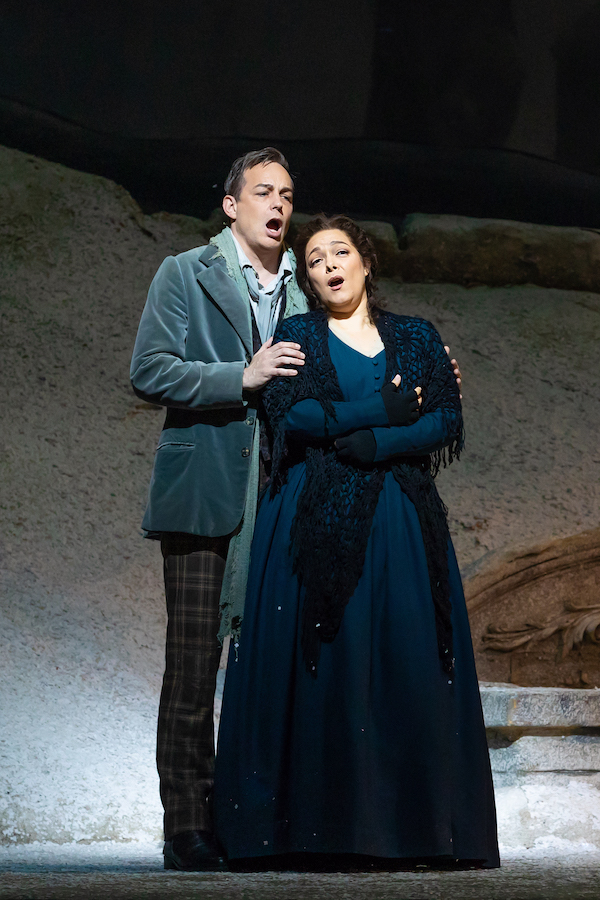Met’s “Bohème” returns with Nézet-Séguin at the helm

Puccini’s La bohème returned to the Metropolitan Opera on Friday evening. The Franco Zeffirelli production has been mounted nearly 500 times since 1981, but when the curtain rises on the Act II Café Momus scene there is still an explosion of applause. A similar outburst greets the appearance of the ensuing act’s bleak snowy early morning at the Barrière d’Enfer. Such spectacle and hyper-realism have all but vanished in opera houses, but Zeffirelli’s La bohème endures.
The musical draw this time was the Met’s music director Yannick Nézet-Séguin conducting the opera for the first time in the house. His appearance on the podium garnered an ovation that surpassed that of the audience’s first sight of nearly 240 people filling the streets of Paris in Act II. Nézet-Séguin conducted Puccini’s beloved in his much-appreciated manner – a detailed, meticulously prepared approach to the score, emotion motion drawn from every measure, shimmering pianissimi as well resounding fortes from the orchestra—yet all at the service of the drama.
The one shortfall was balance, which can be Nézet-Séguin’s Achilles’ heel. It was most apparent in Act I, where at times one strained to hear the singers, particularly when they were engaging in fast, free-flowing banter in the middle of their ranges. This, however, was never the case when the cast was singing in the upper ranges with the orchestra cushioning them with glorious sound, or the most intimate exchanges between Eleonora Buratto’s Mimi and Stephen Costello’s Rodolfo.
Buratto was an affecting Mimi, a role she sang at the Met for the first time last season. Her Mimi has the definite whiff of the opportunist about her. Although hidden from Rodolfo’s view, she gleefully blows out her candle, and clearly has a shopping habit. It is however passion, vulnerability and fragility that one seeks in a Mimi, and Buratto’s seamstress overflows with those qualities.
The role of Mimi is also a perfect fit for Buratto vocally. When happy, there is a lightness and luminosity to her singing, even when it is tinged with poignancy as she sings of springtime in “Sì, mi chiamano Mimì”. In the final act, she sings those beautiful melodies once again, but with a more hollow tone and even greater feeling. When passion is called for, Buratto pours out waves of sound, that smolder with emotion and melt one’s heart.
Stephen Costello’s tenor is lean and elegant, as is his appearance, but too light to do full justice to the role. He is at his best in “Che gelida manina” or his duets with Buratto’s Mimi, where Nézet-Séguin gaged the balance perfectly. His adept singing and acting in Act IV, when Rodolfo and Mimi sing of their love and recall memories of the past, added to the all-consuming sadness of the scene.
There is a dark, dangerous edge to Davide Luciano’s Marcello, which makes for a more complex portrayal of the frustrated painter than usual. His dark vibrant baritone was the perfect match for Sylvia D’Eramo’s fiery Musetta who appears on stage in a burst of energy and red velvet. Her “Quando me’n vo’” was an attention grabber, not only for her histrionics, but also the brilliance of her soprano. D’Eramo’s most effective moments, however, were in the last act when she acted and sang with simplicity and honesty.
As Colline, Christian van Horn didn’t opt for the run-of-the-mill aloof philosopher, but added subtle comedic touches to create a complex, three-dimensional character. His fine bass-baritone expressed profound sorrow in his moving “Vecchia zimarra”, which was as much a farewell to his treasured overcoat as it was to innocence.
Alexey Lavrov’s Schaunard was an exceptionally well-crafted character. Lavrov’s high spirits and fine baritone enlivened every scene until the final one, when he was transfixed by Mimi’s impending death. The first to realize that she had died, the young man’s quiet sobbing made the final scene all the more heart rendering.
Donald Maxwell’s avuncular Benoit more than held his own with the four high-spirited young men intent on getting out of paying their rent. He faded into the crowd in his subsequent appearance as Alcindoro, when all eyes were on D’Eramo’s Musetta.
La bohème continues through June 9. Sopranos Susanna Phillips and Latonia Moore, tenor Charles Castronovo, and baritone Quinn Kelsey take over the principal roles, with James Gaffigan conducting, on May 26. metopera.org
Posted Apr 24, 2023 at 9:11 pm by Carol Masterson
As an opera buff of 30+ yrs, I was crushed by Friday evening’s “baton-on-steroids meets anemic, operatic teething rattle.” Puccini’s La Boheme is the virtual wellspring of opera, perpetually renewing money, talent, & supporters. I strained to hear the tenor deliver, the soprano out-“output” the music; & the production raced to the end of the page faster than those two famous notes..TaDum!
Someone was asleep at the switch. Fix it.
Posted Apr 26, 2023 at 4:51 pm by curtis rittenhouse
Mr. Perdian the reviewer got this first performance right. I have a hunch how the voices come across has a little to do with where one is sitting in this enormous space. Also it is no venue for the faint of voice. Nezet-Seguin’s conscientious approach to everything he conducts pays off here. I have heard him conduct many times and I never thought he was ever just beating time. And he wasn’t Friday night. Puccini was well served. The cast was very good. No superstars.
Perdian picked up something I also noticed. The sets still get a round of applause many years after their first appearance. The stage direction was effective.